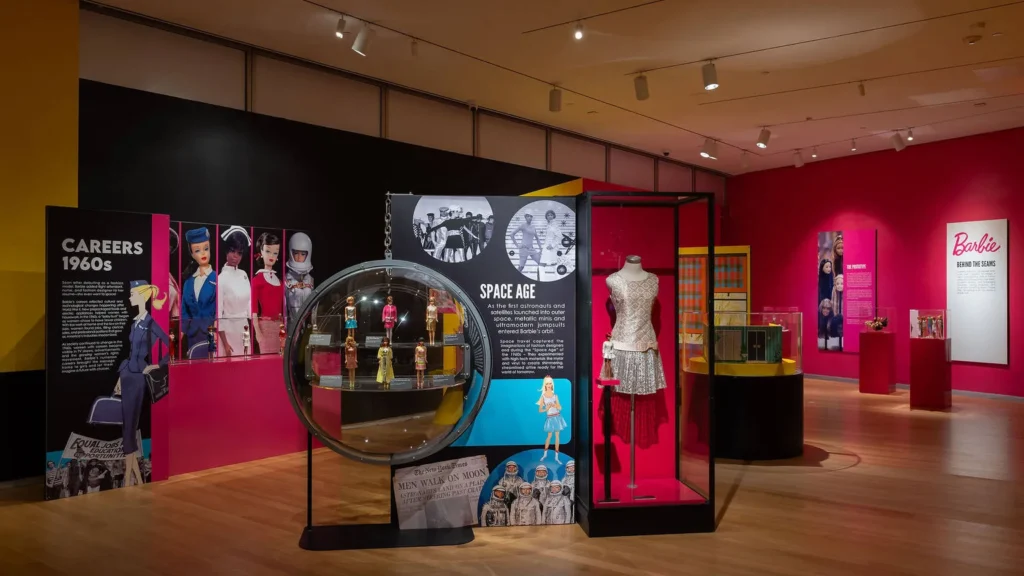The Museum of Arts and Design’s (MAD) exhibit “Barbie: A Cultural Icon” comes at a time when Barbie is experiencing a resurgence, thanks to the 2023 Barbie film, which rekindled global interest in the iconic doll. The exhibit, running from October 19, 2024, to March 16, 2025, offers an in-depth look at Barbie’s 65-year history and cultural impact. Curated by Karan Feder, the exhibit features over 250 vintage dolls and life-size fashion designs, all drawn from private collections, including that of David Porcello and Mattel. This collection not only showcases Barbie’s evolution in terms of fashion but also offers a lens through which we can explore the cultural and social transformations that have shaped America and the world over the past six decades.
Launched in 1959 by Ruth Handler, Barbie was introduced as a revolutionary toy. Unlike the baby dolls and paper dolls of the time, Barbie presented a grown-up, independent woman—a novelty that sparked fascination and criticism alike. The exhibit at MAD begins by exploring Barbie’s origins, featuring the first-ever Barbie doll and the original 22 ensemble outfits that were sold alongside her. At her debut, Barbie represented a bold new image of femininity. She wore a striped swimsuit and stiletto heels, a far cry from the nurturing, motherly image promoted by other dolls.
Critics initially attacked Barbie for promoting unrealistic beauty standards and an excessive consumerist mentality. The exhibit doesn’t shy away from addressing these controversies but instead presents them as part of Barbie’s ongoing dialogue with society. Through original advertisements and interviews with her designers, the exhibit invites viewers to reflect on how Barbie’s design mirrored the ambitions, anxieties, and ideals of American society in the late 1950s and early 1960s. During this period, the doll embodied the post-war optimism and growing consumerism of the era, offering a fantasy of independence and glamour that captured the imagination of young girls.
One of the most compelling aspects of “Barbie: A Cultural Icon” is its focus on how the doll has evolved alongside major social movements, particularly the Space Age, the Civil Rights Movement, and the Women’s Liberation Movement. The exhibit tracks these changes through Barbie’s wardrobe and design over the decades. For instance, Space Barbie from 1965, which anticipates the moon landing, speaks to America’s obsession with space exploration and technological advancements during the 1960s. On the other hand, the introduction of the first Black Barbie in 1980 and later dolls of varying ethnicities in the 1990s and 2000s reflect the growing push for diversity and representation in American culture.
MAD’s display of these groundbreaking dolls is paired with historical context, offering a critical examination of how Barbie both reflected and responded to societal shifts. The introduction of Barbie with different skin tones, hair textures, and even body types is particularly significant, signaling the doll’s gradual move away from her earlier, Eurocentric beauty ideal. In this way, Barbie became not just a toy, but a barometer for cultural change—both responding to and shaping public discourse around race, gender, and identity.
At the heart of the exhibit is a meticulous examination of Barbie’s role in fashion. From her earliest outfits designed by Charlotte Johnson to collaborations with high-end designers like Oscar de la Renta and Christian Dior, Barbie has long been a fashion icon. Her wardrobe has mirrored every major fashion trend from the 1960s onward, including mod, disco, punk, and streetwear. The exhibit includes an array of Barbie dolls dressed in these iconic styles, allowing visitors to trace the evolution of American and global fashion through the lens of a plastic doll.
MAD also highlights how Barbie became a platform for high fashion, with top designers creating exclusive outfits for the doll. For example, the Oscar de la Renta Barbie collection in the 1980s represented one of the first major collaborations between a toy brand and a luxury designer. These partnerships elevated Barbie from a children’s toy to a bona fide fashion symbol, a role she continues to play today as brands like Moschino and Balmain continue to release Barbie-inspired collections. The exhibit pays tribute to these connections, displaying both dolls and life-size versions of the outfits.
A critical element of Barbie’s history—and one of the most contentious aspects of the exhibit—is the ongoing debate about body image. For much of her existence, Barbie has been criticized for her unrealistic proportions, with detractors arguing that her figure promotes unattainable beauty standards for young girls. MAD addresses this debate head-on, presenting the evolution of Barbie’s body over time. In the early 2000s, Mattel introduced Barbies with more diverse body types, including dolls with different heights, body shapes, and physical abilities.
This change was not just cosmetic but deeply symbolic, reflecting the broader societal move towards body positivity and inclusivity. The exhibit places these Barbies in the context of the ongoing dialogue around body image, media representation, and self-esteem, asking visitors to consider how toys shape children’s understanding of beauty and identity. By showcasing dolls that reflect a broader range of body types, the exhibit challenges the notion that Barbie is an outdated or regressive symbol, instead positioning her as a figure capable of adapting to new cultural norms.
Impression
Perhaps one of the most fascinating aspects of Barbie: A Cultural Icon is the way it positions Barbie as both a product of her time and a shaper of culture. For many, Barbie has been a mirror reflecting societal ideals, anxieties, and aspirations. At different points in her history, Barbie has been everything from a career woman to a stay-at-home mom, a princess to an astronaut. Each iteration of the doll offers a glimpse into the American psyche at the time of her creation.
The exhibit also explores Barbie’s global impact, noting how she has been adapted and embraced by cultures around the world. From Japan to Latin America, Barbie has taken on different forms and meanings, becoming a symbol of globalization and cultural exchange. In Japan, for example, Barbie was reimagined as a more kawaii (cute) figure, while in Latin America, she has been marketed with darker skin tones and features to better represent local beauty ideals.
As the exhibit draws to a close, it invites viewers to consider what the future holds for Barbie. In an age of increasing awareness about gender identity, racial diversity, and environmental sustainability, how will Barbie continue to evolve? Recent efforts by Mattel to make Barbie more inclusive—including the introduction of dolls with prosthetic limbs, hearing aids, and vitiligo—suggest that the brand is committed to staying relevant in a rapidly changing world.
At the same time, Barbie faces competition from newer, more explicitly feminist dolls, like the Lammily doll, which was designed to have more realistic proportions and emphasize educational achievements over fashion. How Barbie will navigate these cultural shifts remains to be seen, but the exhibit makes clear that she is a resilient figure, capable of adapting to the demands of new generations.
The Barbie: A Cultural Icon exhibit at the Museum of Arts and Design offers a comprehensive and nuanced look at America’s favorite doll. Through 65 years of history, Barbie has been at once a mirror of societal trends and a catalyst for cultural change. From her early days as a symbol of post-war optimism to her more recent role as an advocate for diversity and body positivity, Barbie has proven to be far more than just a toy.
MAD’s exhibit invites viewers to engage critically with Barbie’s legacy, considering not just her impact on fashion and popular culture, but also her role in shaping conversations about identity, race, and gender. As Barbie continues to evolve, her legacy as a cultural icon is secure, reminding us that even the most seemingly simple objects can hold profound meaning.
No comments yet.








